Network SouthEast Publicity
The early days of NSE
Introduction
Richard Sharp was Advertising Manager for London & South East/Network SouthEast between 1984 and 1987. I am very pleased that
Richard has agreed to document his work for NSE over that exciting period. This whole website is a tribute to people
like Richard and dynamic managers like Chris Green who have provided us with such superb advertising material over so
many years.
The following commentary shows how much background work goes into the production of leaflets, posters and TV commercials.
Tony Hillman
Three passenger sectors were established; Inter City, Provincial and London & South East (L&SE). Unlike the other two sectors, L&SE was primarily a commuter railway moving nearly 400,000 passengers in and out of central London every weekday, four times as many people as were involved in the D-Day landings of World War 2 (a statistic that was to be used in advertising at a later stage).
37% of London commuters used rail. L&SE was the largest suburban railway in the world, stretching from King‘s Lynn to Weymouth, Northampton to Ramsgate and Banbury, Whimple and Bedwyn in the west. Initially under the directorship of David Kirby, L&SE was tasked to reduce its call on Government subsidy by 36%, from £322 million to £205 million p.a. in three years. This was achieved. By 1986 total costs for the sector were £873 million against revenue of £668 million, the least subsidised railway in Europe and in the top 20 of UK companies in terms of annual turnover.
Late in 1985 Chris Green started to take up the reins as Sector Director L&SE. Chris was a brilliant career railwayman and had already revitalised Scotland‘s railways under the ScotRail brand, having previously been General Manager for BR‘s Southern Region. David Kirby stepped up to be Sir Robert Reid‘s Vice Chairman at the British Railways Board.
Over the following seven months the concept of Network Southeast (NSE) was developed and evolved as the brand for the new sector. Twelve sub sectors were also created representing the various geographic areas and BR Regions that made up NSE. There were four Regional General Managers - Southern, Eastern, Midland and Western, there to bring new life and imagination to the way the railway is run.
Network SouthEast was launched to its customers and
the press on Tuesday 10th June 1986.
To achieve this NSE set itself two major strategic objectives -
Significant improvements were also made to daily train cleaning (from
65% to 87% of the fleet) and also to the prompt answering of telephone enquiries to the sector‘s Telephone Enquiry Bureaux.
The one target that remained difficult to reach was for the reduction in passenger overcrowding during peak periods.
The objective was for commuters never to have to stand for longer than 20 minutes, in normal circumstances.
How was this achieved?
Unlike today‘s railways, fully integrated team work across train crews, station staff, signallers, all engineering departments, etc was already part of the culture and organisational structure of British Rail. Chris Green was able to capitalise on this. Priority was given to improving staff morale and pride in their new network. Chris went out of his way to meet the vast majority of his 41,000 staff during those first few months. Priority was given to improving staff accommodation and mess rooms (long before any of the lamp posts were painted!) The result was a significant improvement in staff motivation and job satisfaction.
At the same time a £10million tactical investment transfusion was ring fenced from the above budget revenue receipts achieved in 1985/86. The sector had carried 9 million more passengers during the year and seen a 4% increase in commuting. The money was spent on -
This extra money was on top of the capital investment programme of £82 million for 1986/87 and £117 million in 1987/88. This covered the major electrification schemes, the development and building of new rolling stock (Networkers, Wessex Electrics, etc), new station openings, etc.
While the name Network SouthEast had already been chosen, the branding, look and image had to be evolved. The objectives were to establish Network SouthEast as an entity in the minds of the vast population covered by the sector (22 million people) and to quickly build credibility, customer loyalty, affinity and a distinct personality. It was also necessary to demonstrate the sector‘s determination to deliver, something that two previous national advertising campaigns - This is the age of the train and We‘re getting there had not really achieved.
Five months determined effort to improve the quality of service through Operation Pride provided the spring board from which to launch both the new sector and the campaign. Similarly June was the perfect time to launch, well away from the pitfalls of service delays due to bad weather and in time to make a determined bid to significantly increase off peak travel and therefore revenue.
The improved quality of service was already becoming evident to many passengers but more tangible benefits were also needed to help demonstrate that NSE‘s determination to make it a new railway.
The new One Day Capitalcard product was a resounding success right from the start with sales averaging 1 million per month by the end of the year. Similarly there was an increase in London commuting and Capitalcard Season Ticket sales, with 250,000 daily commuters using the product.
The initial sales of Network Card were also encouraging but it would not really take off until 1987.
Because of these encouraging results, the sector‘s capital investment programme was boosted to £830 million over the following five years.
Therefore the decision was made to maintain the existing off peak pricing structure for Cheap Day Returns, the new Network Saver range and One Day Capitalcards but to offer discounts to holders of Network Cards. (The revenue loss was compensated by the sale of Network Cards themselves). At the same time local journey opportunities would be highlighted through heavy weight advertising and publicity campaigns. The concept of the Network Summer of Fun was born.
Considerable effort went into identifying really attractive local journey opportunities from 111 groups of stations in Network SouthEast. An integrated communication, advertising and PR programme was developed giving ideas of places to go (including London!), journey times, service frequencies and prices. The discounts available with Network card, including the £1 flat fare for children, were of course highlighted. 111 local leaflets were produced with a total print run of 5 million. 3.3 million leaflets were delivered to homes within a short distance of a station. A major national, local press and magazine campaign ran from 11 May through to the end of September.
Special station leaflet dispensers and a series of Summer of Fun posters were displayed at all NSE stations. Books of discount vouchers to London attractions were given to passengers buying One Day Capitalcards. Special packs including the NSE Leisure map and a discount book giving reductions on entry to 55 attractive venues around the south east were given to all Network Card holders. The idea was to get customers to purchase a Network Card and enjoy the price reductions for both their current and future journeys. The powerful point of sale display in booking halls along with blanket poster coverage helped Booking Clerks to encourage passengers to trade up to Network Cards while they were at the window.
The whole Network Summer of Fun campaign was supported by TV advertising using the new Network Card and One Day Capitalcard commercials. These were run in bursts from early June until 14th August on both the London and TVS channels.
From 11th July the vast majority of the Sector‘s car parks were made free on the weekends. This encouraged families to use the car to and from the station and reduced one of the inconvenience factors of using rail for day trips.
Commuting had increased by 15% in three years with 75% of commuters using Capitalcard Season Tickets. But the huge growth in revenue had come through off peak leisure travel. One Day Capitalcard sales averaged 1.5 million per month with 20% of those being bought by passengers who had not considered using rail before.
The Quality of Service measures also continued to improve. Timekeeping was up to 92% of trains being on time or within 5 minutes of it (the objective had been 90%) and cancellations were down to just 0.2% of timetabled service against a target of 1%. The ambitious target of commuters not having to stand for longer than 20 minutes was not only met but improved upon. There were similar improvements in standards of station and train cleaning, reduced ticket office queues and faster answering of telephone enquiries.
The remaining fleet of new Class 317s for the King‘s Cross and Peterborough services were delivered as were the first 50% of Class 319s for Thameslink and Class 442s for Bournemouth line, ready for the electrification through to Weymouth in May 1988. Lines were reopened between Kettering and Corby plus Oxford to Bicester. New stations were opened at Bicester Town, Corby, Haddenham & Thame Parkway and Lake (Isle of Wight).
Network SouthEast
Richard Edgley (Deputy Director) Tony Skeggs (Marketing Manager)
Roland Harman (Marketing Development Manager) Bernard Cox and Ted Simmonds (NSE Marketing)
Central Advertising Services (BRB)
Alan Wilkinson and Blake Paterson
The Agencies
J Walter Thompson (the lead agency) GPCC Advertising (Capitalcard)
Parlour Wood (tactical publicity) Malcolm Slater Associates (local press, leaflets)
Below The Line Projects (sales promotion) O‘Herlihy Associates (market research)
Peter Canham Cancol & CDL (printing and publicity distribution)
Cooper Thirkell (the Network & London Connections maps).
The following commentary shows how much background work goes into the production of leaflets, posters and TV commercials.
Tony Hillman
Background
In 1983, under the enlightened Chairmanship of Sir Robert Reid, the British Railways Board decided to split the passenger, freight and parcels operations of British Rail into five independent business groups or sectors, spanning the five existing rail Regions. The primary objective was to reduce reliance on Government subsidy, especially for the passenger businesses.Three passenger sectors were established; Inter City, Provincial and London & South East (L&SE). Unlike the other two sectors, L&SE was primarily a commuter railway moving nearly 400,000 passengers in and out of central London every weekday, four times as many people as were involved in the D-Day landings of World War 2 (a statistic that was to be used in advertising at a later stage).
37% of London commuters used rail. L&SE was the largest suburban railway in the world, stretching from King‘s Lynn to Weymouth, Northampton to Ramsgate and Banbury, Whimple and Bedwyn in the west. Initially under the directorship of David Kirby, L&SE was tasked to reduce its call on Government subsidy by 36%, from £322 million to £205 million p.a. in three years. This was achieved. By 1986 total costs for the sector were £873 million against revenue of £668 million, the least subsidised railway in Europe and in the top 20 of UK companies in terms of annual turnover.
Late in 1985 Chris Green started to take up the reins as Sector Director L&SE. Chris was a brilliant career railwayman and had already revitalised Scotland‘s railways under the ScotRail brand, having previously been General Manager for BR‘s Southern Region. David Kirby stepped up to be Sir Robert Reid‘s Vice Chairman at the British Railways Board.
Over the following seven months the concept of Network Southeast (NSE) was developed and evolved as the brand for the new sector. Twelve sub sectors were also created representing the various geographic areas and BR Regions that made up NSE. There were four Regional General Managers - Southern, Eastern, Midland and Western, there to bring new life and imagination to the way the railway is run.
the press on Tuesday 10th June 1986.
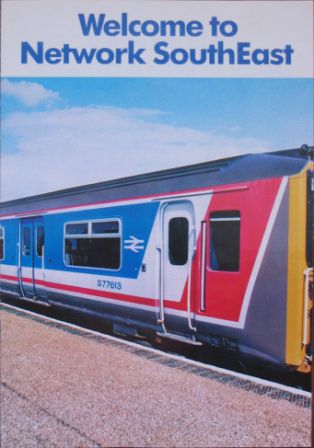 Leaflet distributed on 10th June
Leaflet distributed on 10th June | Understandably the drive to reduce subsidy remained one of the sector‘s key priorities but further dramatic savings were unlikely. It was thought that NSE could break even but would rely on Government to cover major infrastructure and investment costs (for track and signalling) as it did for roads (for building and maintenance). To cover all of its costs and investment needs, season ticket prices would have to be increased by 25% and for passenger numbers to stay the same. This was neither acceptable to Government nor the sector‘s commuters. Government had indicated that an annual subsidy level of around £205 million was bearable in the short term. But in his letter to BR‘s Chairman on 21st October 1986 John Moore, Secretary of State for Transport laid down new objectives for NSE. By 1990 the sector was to reduce operating costs further and to make a significant reduction in the grant requirement from Government. |
- To significantly improve punctuality, reliability (reducing cancellations and the number of peak time trains running with a shorter number of coaches than scheduled) and overall customer care - Operation Pride.
- To increase off peak travel, and therefore revenue, when a lot of the sector‘s assets were under used - Marketing. This would be key to meeting the Government‘s requirements.
Operation Pride
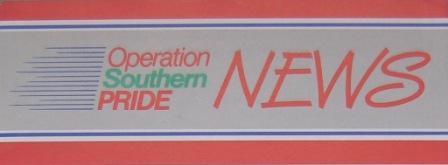 Banner from staff leaflet produced in 1986.
Banner from staff leaflet produced in 1986.
| Operation Pride was launched in February 1986 with the sole intention of improving the quality of service for both commuters and off-peak travellers. Over the five months leading to the launch of NSE timekeeping over the twelve sub sectors improved from 84% to 90% of rush hour trains arriving on time or within five minutes of it. Service cancellations were reduced from 2% of the timetabled service to just 1.4%. |
How was this achieved?
Unlike today‘s railways, fully integrated team work across train crews, station staff, signallers, all engineering departments, etc was already part of the culture and organisational structure of British Rail. Chris Green was able to capitalise on this. Priority was given to improving staff morale and pride in their new network. Chris went out of his way to meet the vast majority of his 41,000 staff during those first few months. Priority was given to improving staff accommodation and mess rooms (long before any of the lamp posts were painted!) The result was a significant improvement in staff motivation and job satisfaction.
At the same time a £10million tactical investment transfusion was ring fenced from the above budget revenue receipts achieved in 1985/86. The sector had carried 9 million more passengers during the year and seen a 4% increase in commuting. The money was spent on -
- The recruitment of 1,700 extra staff - train crews, booking and telephone enquiry personnel, station and train cleaning teams.
- Brightening up key stations and providing more car parking where possible.
- Staff training.
- Refurbishing coach interiors.
- Major investment in new passenger information systems.
- Improvements for wheel chair travellers, extra ramps, accessible toilets and better staff awareness about the needs of the disabled.
- Marketing.
This extra money was on top of the capital investment programme of £82 million for 1986/87 and £117 million in 1987/88. This covered the major electrification schemes, the development and building of new rolling stock (Networkers, Wessex Electrics, etc), new station openings, etc.
Marketing
Planning for a major marketing campaign started on Thursday 12th December 1985. The campaign would break on launch day, Tuesday 10th June 1986.While the name Network SouthEast had already been chosen, the branding, look and image had to be evolved. The objectives were to establish Network SouthEast as an entity in the minds of the vast population covered by the sector (22 million people) and to quickly build credibility, customer loyalty, affinity and a distinct personality. It was also necessary to demonstrate the sector‘s determination to deliver, something that two previous national advertising campaigns - This is the age of the train and We‘re getting there had not really achieved.
Five months determined effort to improve the quality of service through Operation Pride provided the spring board from which to launch both the new sector and the campaign. Similarly June was the perfect time to launch, well away from the pitfalls of service delays due to bad weather and in time to make a determined bid to significantly increase off peak travel and therefore revenue.
The improved quality of service was already becoming evident to many passengers but more tangible benefits were also needed to help demonstrate that NSE‘s determination to make it a new railway.
|
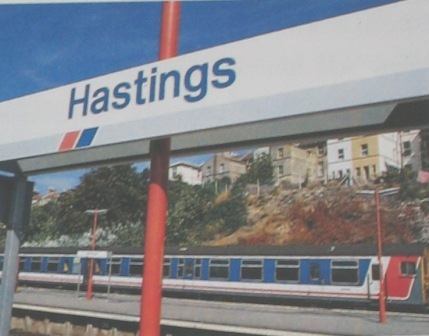
|
The 1986 advertising campaign
The name Network SouthEast was easier to market than London & South East. It emphasised a truly integrated network for the railways of the south east and lent itself to memorable sub brands like Network Express and Network Day. Market research indicated that it was memorable and would easily slip into the vocabulary, given sufficient exposure (advertising weight).
| |||||||||||||
Results (1986/87)
Awareness of the Network SouthEast brand grew from zero to 84 % amongst regular users of the system and there were encouraging inroads into the less frequent leisure market with 48% awareness. Over the year there was a further increase of 5% in passenger numbers and a £66 million increase in ticket revenue. Customer satisfaction measures also showed significant improvement.The new One Day Capitalcard product was a resounding success right from the start with sales averaging 1 million per month by the end of the year. Similarly there was an increase in London commuting and Capitalcard Season Ticket sales, with 250,000 daily commuters using the product.
The initial sales of Network Card were also encouraging but it would not really take off until 1987.
Because of these encouraging results, the sector‘s capital investment programme was boosted to £830 million over the following five years.
|
Tonbridge to Hastings electrification was completed. Wickford/Southminster and Romford/Upminster electrification was completed. Electric services started between Peterborough and King‘s Cross. Electric services started between Cambridge and Liverpool Street. Other electrification schemes were started including | |
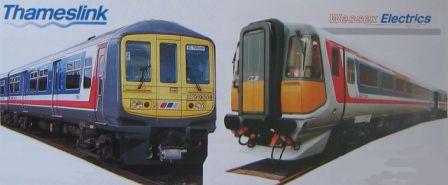 Royston and Cambridge
Royston and CambridgeSouth Croydon to East Grinstead Bournemouth to Weymouth. The new class 442s for the Bournemouth line (Wessex Electrics) and Class 319s for the new Thameslink passenger service went into construction. |
The 1987 marketing and advertising campaign
Having started to establish the NSE brand during 1986 the priority for 1987 was to make significant inroads into the huge and largely untapped leisure market who naturally turned to the car for day and weekend trips. While rail couldn‘t really compete in terms of door to door convenience it certainly could on price and speed, especially for trips to and from central London. Serious consideration was given to reducing the price of off peak tickets but there were constraints to this. One was the very important interface with InterCity. There were parallel services on some routes and NSE was certainly not going to embark on a price war. At the same time InterCity just starting on a sophisticated and carefully segmented marketing drive with the diversification of the Saver range into Red, White and Blue price bands and what was later to become Yield Management i.e. specific pricing by train and the specific journey. Second was the all important agreement with London Transport with the joint Capitalcard products. The pricing of One Day Capitalcards (certainly within the zones) could not be tampered with.Therefore the decision was made to maintain the existing off peak pricing structure for Cheap Day Returns, the new Network Saver range and One Day Capitalcards but to offer discounts to holders of Network Cards. (The revenue loss was compensated by the sale of Network Cards themselves). At the same time local journey opportunities would be highlighted through heavy weight advertising and publicity campaigns. The concept of the Network Summer of Fun was born.
Considerable effort went into identifying really attractive local journey opportunities from 111 groups of stations in Network SouthEast. An integrated communication, advertising and PR programme was developed giving ideas of places to go (including London!), journey times, service frequencies and prices. The discounts available with Network card, including the £1 flat fare for children, were of course highlighted. 111 local leaflets were produced with a total print run of 5 million. 3.3 million leaflets were delivered to homes within a short distance of a station. A major national, local press and magazine campaign ran from 11 May through to the end of September.
Special station leaflet dispensers and a series of Summer of Fun posters were displayed at all NSE stations. Books of discount vouchers to London attractions were given to passengers buying One Day Capitalcards. Special packs including the NSE Leisure map and a discount book giving reductions on entry to 55 attractive venues around the south east were given to all Network Card holders. The idea was to get customers to purchase a Network Card and enjoy the price reductions for both their current and future journeys. The powerful point of sale display in booking halls along with blanket poster coverage helped Booking Clerks to encourage passengers to trade up to Network Cards while they were at the window.
Taking the Network to the People
Running in tandem with the main advertising and station point of sale campaigns, The Network Road Show (two pupose built mobile exhibition units) visited over 90 town centres, fairs and fetes throughout the sector between April and October. The Road show was staffed by local NSE volunteers and meant that new markets could be influenced into thinking about using rail during the summer.The whole Network Summer of Fun campaign was supported by TV advertising using the new Network Card and One Day Capitalcard commercials. These were run in bursts from early June until 14th August on both the London and TVS channels.
From 11th July the vast majority of the Sector‘s car parks were made free on the weekends. This encouraged families to use the car to and from the station and reduced one of the inconvenience factors of using rail for day trips.
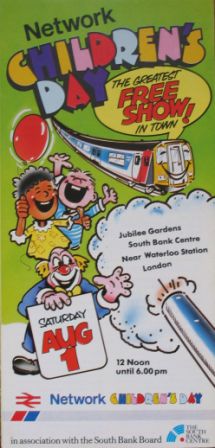
|
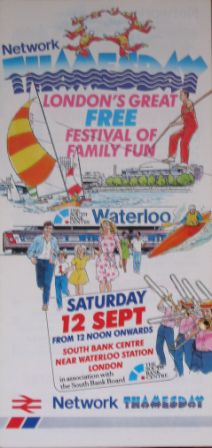
| Another significant element of the 1987 leisure campaign was the sponsorship of two major events on the South Bank at Waterloo.The vast majority of leisure trips within NSE were to and from central London so choosing two major and free funevents in the capital was a natural extension to the Network Summer of Fun campaign. Network Children's Day was held on Saturday 1st August, followed by Thamesday on Saturday 12th September. Both were a huge success. |
| The most important new product launch for commuters came in November with the introduction of Gold Card. This was effectively a free Network Card for holders of Annual Season Tickets and Annual Capitalcards. It gave the holder and up to three other adults 33% discounts on tickets for journeys throughout Network SouthEast, with up to four children travelling for just £1 each. |
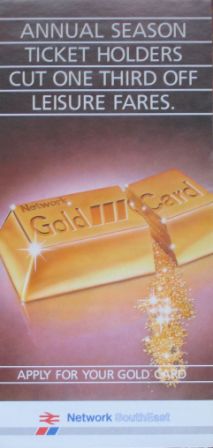
|
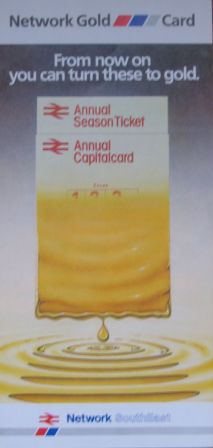
|

|
Results (1987/88)
NSE‘s earnings increased by a record 8.5%, £95 million in real terms compared with 1986/87. Government Grant had been reduced by £230 million (34%) since 1983. At the same time the sector could fund a record level of capital investment.Commuting had increased by 15% in three years with 75% of commuters using Capitalcard Season Tickets. But the huge growth in revenue had come through off peak leisure travel. One Day Capitalcard sales averaged 1.5 million per month with 20% of those being bought by passengers who had not considered using rail before.
The Quality of Service measures also continued to improve. Timekeeping was up to 92% of trains being on time or within 5 minutes of it (the objective had been 90%) and cancellations were down to just 0.2% of timetabled service against a target of 1%. The ambitious target of commuters not having to stand for longer than 20 minutes was not only met but improved upon. There were similar improvements in standards of station and train cleaning, reduced ticket office queues and faster answering of telephone enquiries.
The remaining fleet of new Class 317s for the King‘s Cross and Peterborough services were delivered as were the first 50% of Class 319s for Thameslink and Class 442s for Bournemouth line, ready for the electrification through to Weymouth in May 1988. Lines were reopened between Kettering and Corby plus Oxford to Bicester. New stations were opened at Bicester Town, Corby, Haddenham & Thame Parkway and Lake (Isle of Wight).
1988 and onwards
The marketing and advertising campaigns evolved over the next few years with Alan Wilkinson at the helm as Advertising Manager for Network SouthEast. A spectular TV commercial The bargains start when the rush stops was shot at Waterloo on Sunday 10th April. It went on air from 24th April and run throughout the summer stimulating off peak travel, Network Card and One Day Capitalcard salesThe end of NSE
From 1 April 1994 NSE was split back into 11 separate companies, still under the ‘BR‘ banner but running in shadow franchise mode in readiness for privatisation and the era of Train operating Companies. By then John Nelson was at the helm and his title changed from Managing Director Network SouthEast to Managing Director, South & East, British Railways Board on 1 April 1994. The NSE branding started to disappear from that date (certainly in marketing terms) although it remained on rolling stock livery, station signs, etc for quite a long while after that. Some of the ‘companies‘ temporarily retained the NSE chevrons and colourways, e.g. ‘Network South Central‘. Ticketing products like Gold Card and ‘new‘ Travelcard (that had changed from Capitalcard to Travelcard as far back as 1989) all fell under the auspices of the Association of Train Operating Companies [ATOC]. But marketing budgets were very restricted and little was produced during this period of great uncertainty.Acknowledgements
I had the privilege of being Advertising Manager for (L&SE)/Network SouthEast between 1984 and 1987. It was a very exciting, exhilarating and fantastic experience, the highlight of my career. My sincere thanks go to the Network SouthEast marketing team at Euston and the sub sectors, my own team in BRB‘s Central Advertising Services, the advertising agencies and, of course, to Chris Green himself. Without him none of this would have been achieved.Network SouthEast
Richard Edgley (Deputy Director) Tony Skeggs (Marketing Manager)
Roland Harman (Marketing Development Manager) Bernard Cox and Ted Simmonds (NSE Marketing)
Central Advertising Services (BRB)
Alan Wilkinson and Blake Paterson
The Agencies
J Walter Thompson (the lead agency) GPCC Advertising (Capitalcard)
Parlour Wood (tactical publicity) Malcolm Slater Associates (local press, leaflets)
Below The Line Projects (sales promotion) O‘Herlihy Associates (market research)
Peter Canham Cancol & CDL (printing and publicity distribution)
Cooper Thirkell (the Network & London Connections maps).

 A major PR event was staged at Waterloo between the morning and evening peaks on launch day, Tuesday 10th June.
Journalists and opinion formers were given a presentation about the aims of NSE in the Long Gallery running under
platforms 1 to 19. The newly liveried rolling stock was on display in platforms 1 to 3.
A major PR event was staged at Waterloo between the morning and evening peaks on launch day, Tuesday 10th June.
Journalists and opinion formers were given a presentation about the aims of NSE in the Long Gallery running under
platforms 1 to 19. The newly liveried rolling stock was on display in platforms 1 to 3.

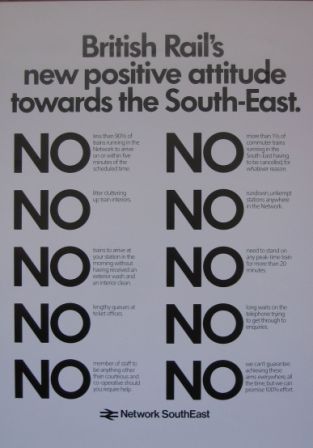




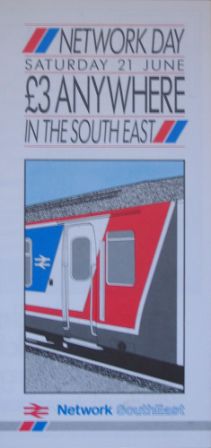 A series of Network Days giving unlimited travel throughout the sector for just £3 for adults and £1 for accompanied
children. The first of these was on Saturday 21st June.
A series of Network Days giving unlimited travel throughout the sector for just £3 for adults and £1 for accompanied
children. The first of these was on Saturday 21st June.
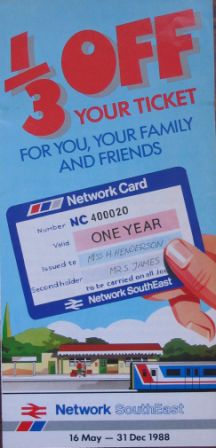 The new Network Card was introduced in September 1986 giving big discounts on off peak tickets for adults and
children. This was also promoted through a major TV campaign and a commercial based on
Love Train, filmed at
Richmond station. The campaign was supported by press ads, a major poster blitz and leaflets.
The new Network Card was introduced in September 1986 giving big discounts on off peak tickets for adults and
children. This was also promoted through a major TV campaign and a commercial based on
Love Train, filmed at
Richmond station. The campaign was supported by press ads, a major poster blitz and leaflets.